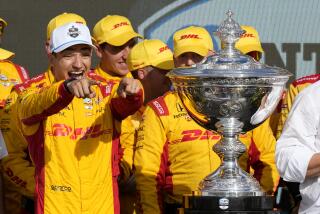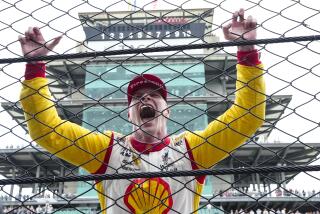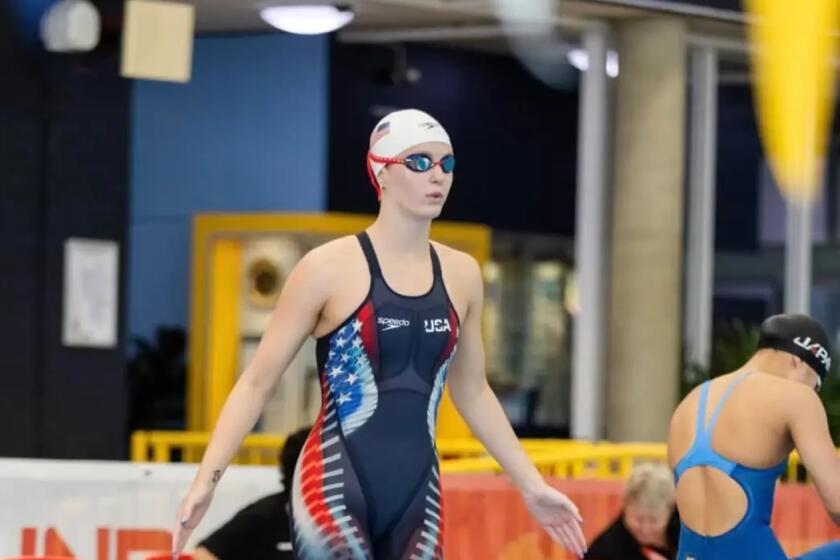Back on Track : Guerrero Returns to Form, and He’s Faster Than Ever
- Share via
INDIANAPOLIS — Rarely in motor racing has a driver’s good fortune been so universally applauded as the surprising appearance of Roberto Guerrero as the fastest driver in Indianapolis 500 history.
Guerrero, 33, once one of racing’s young lions, survived a nearly fatal crash testing a car at Indianapolis late in 1987, then sank into racing oblivion with a failing team in 1989 and 1990.
So, when he suddenly emerged this spring, driving 230-m.p.h. laps in a new Lola-Buick, it came as a bit of a shock to many. Usually, such success is met with skepticism, criticism or plain old envy among the racing corps.
Not so with Guerrero.
“I hope his time (2 minutes 34.851 seconds for 10 miles) holds up,” defending 500 champion Rick Mears, a four-time Indy winner, said after Guerrero had qualified at 232.482 m.p.h. last Saturday.
“He and Katie deserve it. I think it’s wonderful.”
Roberto and wife Katie are linked in conversation so closely that an outsider might think they both drive the car. In spirit, Guerrero says, they do.
“If it wasn’t for her, I probably wouldn’t be here today,” he said. “I probably wouldn’t be anywhere. She is the one who sat with me all that time while I took a long, long sleep.”
Guerrero was in a coma at Methodist Hospital here for 17 days in 1987 after he was hit in the head by one of the wheels that flew off his car when it smashed into the concrete wall. Doctors gave him little chance of recovery and no chance of returning to the wheel of a race car.
“I just couldn’t give up,” Katie said later. “Roberto was my life. I kept staring at those monitors so hard that I think I willed him to get well.”
Roberto and Katie were racing’s storybook couple even before the accident. Roberto Jose Guerrero Isaza was the dashing race driver from Medellin, Colombia, and Katie the sun-washed Southern California beauty when they met and fell in love in 1981 in Monte Carlo. They moved to Southern California in 1984, and Guerrero began driving Indy cars after a brief experience in Formula One.
In January of 1990, Guerrero was sworn in as a naturalized American citizen in Los Angeles.
“I felt like I had won a major race that day,” he said of the citizenship ceremony.
The couple live in San Juan Capistrano with their sons, Marco, 6, and Evan, 4.
“The birth of our children were the proudest moments of my life,” Guerrero says.
Those were the happy moments and to fully appreciate the heights to which Guerrero has soared this month, the depths must be explored.
In mid-1987, he was one of the hottest properties in Indy car racing. He had won two races, at Phoenix and Mid-Ohio, had sat on the pole four times and had finished second to Al Unser under heartbreaking circumstances in the Indianapolis 500.
Guerrero was leading by more than a lap at Indy after pacesetter Mario Andretti had coasted to a stop with 20 laps to go. Guerrero, with time to spare, made his final pit stop. Forty-five miles to go and he would have racing’s most treasured prize.
But when he hit the accelerator on Vince Granatelli’s March-Cosworth, the engine died. Before the crew could get it restarted, Unser had circled the track nearly twice and beat Guerrero to the finish line by 4.496 seconds, one of the narrowest margins in race history.
“It was the biggest disappointment of my life,” he recalled this week. “I think the only way I can get it out of my mind is to win this year’s race.”
Even with that disappointment, however, Guerrero had the best Indy record among non-winners: 2-3-4-2 in his first four races. Only Bill Holland, 2-2-1-2 starting in 1947, had done better in his first four years at Indy.
Then, on Sept. 10, 1987, he had the accident.
“I admit that in my heart, the last thing I wanted was for Roberto to get back in a race car,” Katie says. “But once he began to recover, I knew there was nothing he wanted more. I knew he had to do it and I had to help him every way I could.”
Then she added, “I would rather the boys be golfers.”
Guerrero’s recovery seemed complete when he returned to the Indy car circuit in 1988 and finished second at Phoenix in the year’s opening race. The next season, he signed with Alfa Romeo to be their No. 1 driver in developing a competitive Indy car.
“It looked so promising at the time,” Guerrero says. “I felt I had a solid future with the team, but it wasn’t long before I realized things were not likely to work out.”
The car was late arriving from Italy and the team missed the Indianapolis 500. Guerrero finally drove the Alfa at Detroit, finishing eighth. It was the best it would do.
“The whole project became so political, it couldn’t work,” he said. “Johnny Capels was the team manager, but if he wanted to make a change, even a small part of the suspension, he had to go through five or six people before he could make it. It was management by committee and it didn’t work. When the car didn’t perform like they expected, Capels became the scapegoat and they fired him.
“No one at Alfa wanted to accept any blame. The second year, the car still didn’t work so I was the scapegoat. I got fired. The next year they tried Danny Sullivan and when he couldn’t get it to work, either, they quit. It was too bad. I think if they had let Capels and me alone, we could have developed a good car, but it couldn’t happen in that environment.”
Last year, Guerrero was primarily an unemployed driver. After Indianapolis, when he and Kevin Cogan were eliminated in an early-race crash, Guerrero sat idling in San Juan Capistrano while Granatelli tried, without success, to raise sponsorship money.
Late in the season, Kenny Bernstein called about having him drive in three road races.
“Jim Crawford was our driver, but when the sponsors wanted a car at Detroit, Denver and Laguna Seca, we had to find someone else because Jim can’t drive road courses because of his legs (which were severely injured in a crash several years ago),” Bernstein said. “We made up a list of possible drivers, and Roberto was at the top of the list.
“We knew he was a fine driver who had been through some tough times, but we didn’t know what a jewel we had. From the moment he got in the car last September, Roberto brought a lot to the table.
“When we got our new Lolas for this year, we decided to go with two drivers for Indy. . . . Our goal from the start was to have a team effort. Roberto helped Jim a great deal, and Jim has helped Roberto. They make a great team.”
Guerrero said that having two drivers gave the team greater input.
“After every test day, we go over everything we’ve done, Jim, myself, John Travis (chief Lola engineer), Kenny and the Buick people and discuss every detail,” Guerrero said. “We usually talk things over until 8 or 8:30 in the evening. That’s why we’ve made such progress.”
Now that he is on the pole, Guerrero is focusing on the 500-mile race May 24.
“Indianapolis is two races,” Guerrero said. “We have won the first one. Now we must settle down and work on winning the big one.
“I keep hearing talk about the lack of reliability in the Buick engine, but Jim and I have put in a lot of miles here, so I see no reason why it shouldn’t be as reliable as any other engine. Certainly there’s a chance the Buick can break, but so can a proven Chevrolet.
“And I can’t say enough about the chassis that Lola built. The car is just beautiful. From the first time I sat in it, I knew it was a dream. Just a beautiful dream.”
More to Read
Go beyond the scoreboard
Get the latest on L.A.'s teams in the daily Sports Report newsletter.
You may occasionally receive promotional content from the Los Angeles Times.










